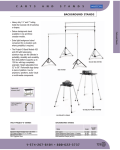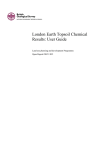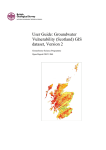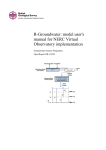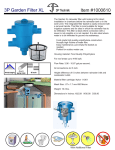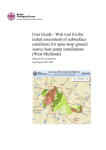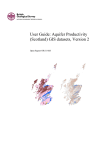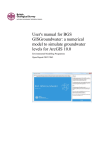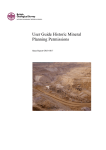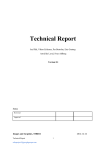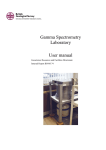Download User Guide for the British Geological Survey National Depth to
Transcript
User Guide for the British Geological Survey National Depth to Groundwater Dataset Groundwater Programme Open Report OR/15/006 BRITISH GEOLOGICAL SURVEY GROUNDWATER PROGRAMME OPEN REPORT OR/15/006 User Guide for the British Geological Survey National Depth to Groundwater Dataset A A McKenzie The National Grid and other Ordnance Survey data are used with the permission of the Controller of Her Majesty’s Stationery Office. Licence No: 100017897/2015. Keywords Groundwater, Hydrogeology, Water level. Front cover Groundwater level across Great Britain Bibliographical reference MCKENZIE, A.A.. 2015. User Guide for the British Geological Survey National Depth to Groundwater Dataset. British Geological Survey Internal Report, OR/15/006. 16pp. Copyright in materials derived from the British Geological Survey’s work is owned by the Natural Environment Research Council (NERC) and/or the authority that commissioned the work. You may not copy or adapt this publication without first obtaining permission. Contact the BGS Intellectual Property Rights Section, British Geological Survey, Keyworth, e-mail [email protected]. You may quote extracts of a reasonable length without prior permission, provided a full acknowledgement is given of the source of the extract. Maps and diagrams in this book use topography based on Ordnance Survey mapping. © NERC 2015. All rights reserved Keyworth, Nottingham British Geological Survey 2015 BRITISH GEOLOGICAL SURVEY The full range of our publications is available from BGS shops at Nottingham, Edinburgh, London and Cardiff (Welsh publications only) see contact details below or shop online at www.geologyshop.com The London Information Office also maintains a reference collection of BGS publications, including maps, for consultation. We publish an annual catalogue of our maps and other publications; this catalogue is available online or from any of the BGS shops. The British Geological Survey carries out the geological survey of Great Britain and Northern Ireland (the latter as an agency service for the government of Northern Ireland), and of the surrounding continental shelf, as well as basic research projects. It also undertakes programmes of technical aid in geology in developing countries. The British Geological Survey is a component body of the Natural Environment Research Council. British Geological Survey offices BGS Central Enquiries Desk Tel 0115 936 3143 email [email protected] Fax 0115 936 3276 Kingsley Dunham Centre, Keyworth, Nottingham NG12 5GG Tel 0115 936 3241 Fax 0115 936 3488 email [email protected] Murchison House, West Mains Road, Edinburgh EH9 3LA Tel 0131 667 1000 email [email protected] Fax 0131 668 2683 Natural History Museum, Cromwell Road, London SW7 5BD Tel 020 7589 4090 Fax 020 7584 8270 Tel 020 7942 5344/45 email [email protected] Columbus House, Greenmeadow Springs, Tongwynlais, Cardiff CF15 7NE Tel 029 2052 1962 Fax 029 2052 1963 Maclean Building, Crowmarsh Gifford, Wallingford OX10 8BB Tel 01491 838800 Fax 01491 692345 Geological Survey of Northern Ireland, Colby House, Stranmillis Court, Belfast BT9 5BF Tel 028 9038 8462 Fax 028 9038 8461 www.bgs.ac.uk/gsni/ Parent Body Natural Environment Research Council, Polaris House, North Star Avenue, Swindon SN2 1EU Tel 01793 411500 Fax 01793 411501 www.nerc.ac.uk Website www.bgs.ac.uk Shop online at www.geologyshop.com OR/15/006 Foreword This report presents a description and review of the methodology developed by the British geological Survey (BGS) to produce a national scale dataset of depth to groundwater. The method has been critically assessed and its fitness for purpose determined by scientists who specialise in hydrogeology at BGS. The purpose of this user guide is to enable those licensing this dataset to have a better appreciation of how the dataset has been created and therefore better understand the potential applications and limitations that the dataset may have. i OR/15/006 Contents Foreword ......................................................................................................................................... i Contents.......................................................................................................................................... ii Summary ....................................................................................................................................... iii Acknowledgements ....................................................................................................................... iii 1 Introduction ............................................................................................................................ 1 2 About the national depth to groundwater dataset .............................................................. 1 2.1 Background ..................................................................................................................... 1 2.2 Who might require these data? ....................................................................................... 3 2.3 What the dataset shows? ................................................................................................. 3 3 Technical Information ........................................................................................................... 4 3.1 Definitions ...................................................................................................................... 4 3.2 Scale................................................................................................................................ 4 3.3 Field Descriptions ........................................................................................................... 4 3.4 Creation of the Dataset ................................................................................................... 4 3.5 Dataset History ............................................................................................................... 6 3.6 Coverage ......................................................................................................................... 6 3.7 Data Format .................................................................................................................... 7 3.8 Limitations ...................................................................................................................... 7 4 Licensing Information ........................................................................................................... 9 FIGURES Figure 1 Density of depth to groundwater observations ............................................................ 2 Figure 2 The coverage of the BGS national groundwater level dataset .................................... 7 TABLES Table 1 Depth to groundwater level attribute table field descriptions......................................... 4 Table 2 Supplementary attribute table field descriptions ............................................................ 4 Table 3 Guidance on interpretation of levels ............................................................................... 6 ii OR/15/006 Summary This report presents a description and review of the methodology developed by the British Geological Survey (BGS) to produce a national scale dataset of depth to groundwater. The resulting dataset is a raster grid, with 50 x 50 metre pixels holding values that represent the probable maximum depth, in metres, to the water table. The dataset has been modelled from topography and hydrology, assuming that surface water and groundwater are hydraulically connected. The dataset has not used observations of groundwater level in wells or boreholes directly, but they have been used to validate its performance. Users of the dataset will need to take into account the limitations of the model, and make due allowances for the way in which actual groundwater levels may vary spatially and temporally from the model. The method has been critically assessed and its fitness for purpose determined by hydrogeological specialists in BGS. Acknowledgements A number of individuals in the Information Products and Groundwater Science Directorates have contributed to the project and helped compile this report. This assistance has been received at all stages of the study. iii OR/15/006 1 Introduction Founded in 1835, the British Geological Survey (BGS) is the world's oldest national geological survey and the United Kingdom's premier centre for earth science information and expertise. The BGS provides expert services and impartial advice in all areas of geoscience. Our client base is drawn from the public and private sectors both in the UK and internationally. Our innovative digital data products aim to help describe the ground surface, and what is beneath, across the whole of Great Britain. These digital products are based on the outputs of the BGS survey and research programmes and our substantial national data holdings. These data coupled with our in-house geoscientific knowledge provide products relevant to a wide range of users in central and local government, insurance and housing industry, engineering and environmental business, and the British public. Further information on all the digital data provided by the BGS can be found on our website at http://www.bgs.ac.uk/products/home.html or by contacting: Central Enquiries British Geological Survey Kingsley Dunham Centre Keyworth Nottingham NG12 5GG Direct tel. +44(0)115 936 3143 Fax. +44(0)115 9363150 email [email protected] 2 About the national depth to groundwater dataset 2.1 BACKGROUND Groundwater plays a key role in many shallow geological processes, and an estimate of the level of the water table, is an important component of site investigations, assessments of water resources and environmental studies. Data on groundwater level is frequently used as a component within geological models, for instance in studies of slope stability, groundwater flood susceptibility or the suitability of an area for Sustainable Urban Drainage Systems. BGS holds the National Groundwater Level Archive, which is a database of information on groundwater depth derived from a range of sources, including measurements made during borehole drilling, time series data from observation wells and compilations of interpreted data. For site specific investigations these data provide the most reliable source of detailed data, but although measurements are available for over 50,000 wells and boreholes these are very unevenly distributed (Figure 1), with the vast majority concentrated over productive parts of major aquifers). In addition, the measured data at a given point may not represent the natural phreatic1 water table, being influenced by local and regional pumping, or possibly being measurements of potentiometric head in confined aquifers. 1 The phreatic water table refers to a groundwater level where the upper surface is at atmospheric pressure, e.g. not confined by overlying strata 1 BGS©NERC OR/15/006 Observations sites per 10 km2 <1 1-5 1 - 25 25 - 100 >100 Figure 1 Density of depth to groundwater observations The spatial inhomogenity of observations led to exploration of alternative means of estimating groundwater depth to produce a gridded dataset with national coverage, using topography and hydrogeology to calculate model groundwater levels. The approach was piloted in an assessment of groundwater vulnerability in Scotland2. It was subsequently extended to England and Wales as part of a project to develop a dataset of susceptibility to groundwater flooding. The depth to groundwater dataset is one of a range of digital hydrogeological products produced by BGS that include: 2 http://nora.nerc.ac.uk/12231/1/SJG_Vuln2.pdf 2 BGS©NERC OR/15/006 2.2 Ground permeability Susceptibility to groundwater flooding Geological indicators of past flooding Suitability for Sustainable Urban Drainage (SUDS) WHO MIGHT REQUIRE THESE DATA? Information on groundwater level is of direct interest to a number of stakeholders: 2.3 For water well drillers, the depth to groundwater is a key determinant of the cost and likely success of: drilling a borehole for water abstraction; or for the calculating the depth required for, and efficiency of, a ground source heat pump installation. Civil engineers and planners involved in construction and land development need to consider the presence of shallow groundwater, which will influence the design of below ground infrastructure, and whether allowance needs to be made for dewatering excavations or protecting the built environment from water ingress. Groundwater level can also be an important factor in the practicality of mitigating the impact of buildings on runoff to surface water courses through the use of soakaways and SUDS installations. Environmental planners need to identify groundwater bodies that may be an important source of water sustaining wetland habitats. Shallow groundwater may itself be an environmental problem, leading to waterlogging or flooding. Regulators involved in environmental protection must consider depth to groundwater. Generally deep water tables result in long flowpaths for infiltrating water, and enhance the opportunity for potential contaminants in soil or water to be dispersed or degraded before they reach the water table, offering some protection to groundwater bodies. Conversely shallow water tables are normally considered more vulnerable to pollution. WHAT THE DATASET SHOWS? The groundwater level data consists of two data layers in Geographical Information System (GIS) format. The main data layer consists of a gridded depth to groundwater, and a supplementary dataset that identifies areas where extra care is needed in use of the depth to groundwater dataset. These datasets are summarised below and their technical characteristics are reported in Section 3 below. Depth to groundwater The depth to groundwater dataset is a gridded representation of the depth, in metres, from the ground surface to the phreatic water table. This represents the likely lowest water level, under natural conditions, in an open well or borehole drilled into the uppermost parts of a rock unit. Supplementary data The supplementary dataset is a vector overlay that defines some of the areas where phreatic groundwater level may vary significantly from the gridded data. Areas where either superficial sediments or bedrocks have low or very low permeability conditions are of particular concern. If the shallowest superficial material is impermeable, infiltrated water is likely to be trapped and saturate soil. If bedrock is impermeable, overlying sediments may be saturated, depending on local topography, or in some cases the material may be functionally dry, and a water table will not be identifiable. 3 BGS©NERC OR/15/006 3 Technical Information 3.1 DEFINITIONS This dataset is of the depth in metres to the water table, which may also be referred to as ‘phreatic groundwater level’, the ‘rest water level’ or ‘static water level’. Strictly speaking the water table is a concept only applicable to unconfined aquifers; aquifers in which water is free to drain vertically from the ground surface to the aquifer. Confined aquifers occur when a layer of impermeable rock or soil overlies an aquifer that is fully saturated, allowing the water within the aquifer to be pressurised. The groundwater level in a confined aquifer is more properly described as a potentiometric surface, and represents the theoretical level to which water would rise if the confining layer were not present. This dataset does not model levels in confined aquifers. Perched water tables occur when there are lenses of impermeable material in a rock that is otherwise permeable. These allow small localised water tables to develop over the lenses, which can overlay a regional water table in the surrounding rock mass. This dataset does not model perched water tables. 3.2 SCALE The depth to groundwater dataset is produced with a 50 metre pixel resolution; with supplementary data prepared for use at 1:50 000 scale. 3.3 FIELD DESCRIPTIONS Table 1 Depth to groundwater level attribute table field descriptions FIELD NAME FIELD TYPE DESCRIPTION Value Floating point Depth to groundwater from land surface Depths of < 2 metres are rendered as 2 metres Depths of > 100 metres are rendered as 100 metres. Table 2 Supplementary attribute table field descriptions FIELD NAME FIELD TYPE DESCRIPTION Version Text Version information for this dataset Limit Integer Integer identifier of the applicable supplementary information Note Text Description of the issue to be taken into account 3.4 CREATION OF THE DATASET The depth to groundwater dataset is based on a simple conceptual model of interaction between surface water bodies and groundwater. It assumes that groundwater and surface water are in hydraulic continuity, so that groundwater is unlikely ever to be below a surface interpolated between surface water bodies, ‘river base level’. In weakly permeable materials, where drainage is poor, surface water drainage networks are dense, and interpolation will tend to produce groundwater levels relatively close to the ground surface. In highly permeable material, sparse surface water drainage networks mean that groundwater may be at greater depth between surface 4 BGS©NERC OR/15/006 water bodies. While this dataset does not use observations of groundwater level directly, it has been shown to compare well with groundwater levels interpolated from measurements on boreholes in areas where sufficient data are available. To produce the dataset, the following stages are followed: Definition of surface water bodies; Construction of a smoothed surface between surface water bodies; Conversion of the surface from metres above Ordnance Datum to a depth to groundwater, and removal of topographic artefacts; Identification of areas where special care is required in the interpretation of results. The surface water bodies used have been derived from the OS Vectormap District dataset, which is a detailed vector dataset of topographical features with a nominal scale of 1:25,000. Surface water body lines in the dataset represent not only the centreline or banks of rivers, but may also outline ponds and other small water bodies, frequently artificial. Rivers within the dataset are also broken into segments by bridges and other infrastructure. To prepare a dataset that contains only rivers and major water bodies that are likely to be in contact with groundwater, an iterative process was used; gaps and breaks in the surface water lines dataset of less than 50 metres were closed by creating buffered polygons around each line segment, and aggregating overlapping polygons. Major rivers were extracted from a 1:50,000 scale vector map of rivers, and this was supplemented by the OS Vectormap District coastline. A buffer was applied, and all the aggregated polygons enclosing surface water bodies that intersected this buffer were selected. This process effectively identifies major rivers and their tributaries, while ignoring line work that represents isolated ponds and minor watercourses away from river systems. The smoothed surface between the surface water bodies selected was constructed by assigning an elevation to the surface water bodies and the coastline using data from the OSTerrain50 DTM, which is a digital terrain model on a 50 metre grid. A surface was fitted using the ArcGIS Topo to Raster tool, which implements a discretized thin plate spline technique, a surface generation methodology optimised for topographic surfaces based on the ANUDEM algorithm3. Once a surface has been constructed this is converted from an absolute depth in metres relative to Ordnance Datum, to a depth below ground level. In this step a number of corrections are applied. Firstly, the water table is lowered by 1 metre to correct for incision of rivers; this also corrects for the fact that the coastline used in the interpolation represents a mean high sea level, whereas groundwater near the coast is expected to be closer to mean sea level. The data are then subtracted from the OSTerrain50 DTM. In the resulting raster dataset a proportion of levels were found to be above ground level, especially at the base of steep scarp slopes; these are corrected to ground level. In areas of high terrain relief, groundwater levels may be interpolated at unreasonable depths, if the river network is sparse. Observational data suggests that water tables in the UK are almost always above 100 metres below ground level. In areas where water is very shallow presenting the raw data might imply a greater than warranted accuracy. The data are therefore censored to set any levels of > 100 metres to 100 metres, and any of < 2 metres to 2 metres. The final stage of processing involves the identification of areas where particular care is need in interpretation of the data. In this version of the dataset these are primarily areas where low permeability materials have been mapped in the subsurface, derived from the BGS Permeability Index4 dataset. Further areas where special care is needed in interpretation will be added in subsequent releases (e.g. areas under open water and areas of known artesian groundwater). These have been compiled into a vector dataset that provides guidance on the interpretation of the data (Table 3). 3 4 http://resources.arcgis.com/en/help/main/10.1/index.html#/How_Topo_to_Raster_works/009z0000007m000000/ http://www.bgs.ac.uk/products/hydrogeology/permeability.html 5 BGS©NERC OR/15/006 Table 3 Guidance on interpretation of levels LIMIT Note 1 Low permeability superficial material present - soils may be saturated. 2 Low permeability bedrock present - soil or superficial material may be saturated, bedrock may be effectively dry. 3 Low permeability superficial material and bedrock - soil may be saturated, bedrock may be effectively dry. Users requiring groundwater level surfaces can use the OS terrain50 DTM to convert data to metres above ordnance datum. 3.5 DATASET HISTORY BGS is continually surveying and resurveying areas of Britain, improving and updating the geological maps and collecting hydrogeological information. As new data is collected, and conceptual models of groundwater occurrence and flow are improved, so updates are made to hydrogeological products. BGS is committed to improving datasets as more information becomes available. The depth to groundwater dataset discussed in this report, while the first to be formally released as a digital data product, is the third version produced by BGS. Version 1 (released 2004): Depth to groundwater dataset using OS Panorama DTM and surface water bodies derived from OS 1:50,000 mapping. Not released to external users or incorporated into digital data products. Version 2 (released 2007, updated 2010): River base level data derived from NextMap DTM, using a set of surface water bodies also derived from the NextMap DTM. The surface water bodies were subsequently refined by incorporating data on superficial and bedrock permeability. Not released to external users but was incorporated into other BGS digital data products. Version 3 (released 2015): Depth to groundwater dataset completely remodelled, using the OS Opendata OS Terrain50 DTM and surface water bodies from the OS Vectormap District dataset. Supplementary dataset prepared using BGS Superficial and Bedrock Permeability Version 6. 3.6 COVERAGE Data is provided across Great Britain. Northern Ireland and the Isle of Man are not included. 6 BGS©NERC OR/15/006 Figure 2 3.7 The coverage of the BGS national groundwater level dataset DATA FORMAT The groundwater level dataset has been created as a raster dataset in ESRI Grid format. Supplementary data is available as vector polygons. Both datasets are available in a range of alternative GIS formats, including ArcGIS (.shp), ArcInfo Coverages and MapInfo (.tab). More specialised formats may be available but may incur additional processing costs. 3.8 LIMITATIONS Users of the depth to groundwater dataset should understand that it represents a model of how groundwater is expected to behave in the natural environment, and its primary use is in identifying groundwater levels in areas where direct observations are not available, or where having a spatially consistent dataset over large areas is advantageous. The groundwater level dataset has been developed at using a 50 metre resolution DTM, broadly equivalent to 1:50,000 scale, and it should not be used at larger scales. Depth to groundwater can vary significantly within 50 metres, especially in areas with steep relief. 7 BGS©NERC OR/15/006 The depth to groundwater dataset is based on, and limited to, an interpretation of the records in the possession of the British Geological Survey at the time the dataset was created. Depths to groundwater presented in the dataset may vary significantly from those encountered in the field where a borehole is to be drilled or an excavation made. o The depths represent the depth to phreatic groundwater in an unconfined aquifer. o They take no account of seasonal fluctuations, and will generally represent seasonally low water levels. o Sewers, land drainage and artificial waterways may lower or otherwise modify groundwater level locally. o Pumped abstraction for water supply or other purposes (e.g. mine drainage) may lower levels, or artificial discharges may raise levels, both at a regional and a local scale, and over long time periods. o Levels will have been interpolated over open water bodies such as lakes and reservoirs. This needs to be taken into account in using the data to calculate statistics over wide regions (this will be included in supplemental data in future versions) The permeability index data used to identify areas where particular care is need in interpretation of the data, only identifies the permeability of the uppermost geological strata. In particular fluvioglacial and alluvial sediments may present complex layering of permeable and impermeable materials, leading to the development of locally perched water tables. These data are unlikely to be suitable for site specific assessments. If they are to be used for detailed advice to specific sectors of end users, e.g. home-buying, property insurance, site development and construction, then the BGS can provide additional end user guides and additional attribution details for the data. To find more about this, please contact our Business Solutions department through the Central Enquiries Desk using the contact details at the start of this document. 8 BGS©NERC OR/15/006 4 Licensing Information The British Geological Survey does not sell its digital mapping data to external parties. Instead, BGS grants external parties a licence to use this data, subject to certain standard terms and conditions. In general, a licence fee will be payable based on the type of data, the number of users, and the duration (years) of a licence. All recipients of a licence (potential licensees) are required to return a signed digital data licence document to us before authorisation for release of BGS digital data is given. In general terms, a BGS digital data licensee will be permitted to: make internal use of the dataset(s) allow a specified number of internal users to access/use the data (the number of users will be agreed with the licensee and specified in the licence document) for the purposes of their day-to-day internal activities reproduce extracts from the data up to A3 for use in external analogue (paper/hard copy) or non-queryable electronic (e.g. secured .pdf) format: to meet a public task duty; fulfil a statutory requirement; and/or as part of academic or other noncommercial research But will not be permitted to: provide a bureau service for others or incorporate the data in the generation of products or services for commercial purposes sell, assign, sublicense, rent, lend or otherwise transfer (any part of) the dataset(s) or the licence place (any part of) the dataset(s) on the Internet The BGS is committed to ensuring that all the digital data it holds which is released to external parties under licence has been through a robust internal approval process, to ensure that geoscientific standards and corporate quality assurance standards are maintained. This approval process is intended to ensure that all data released: (i) is quality assured; (ii) meets agreed BGS data management standards; (iii) is not in breach of any 3rd party intellectual property rights, or other contractual issues (such as confidentiality issues), that would mean that release of the data is not appropriate. When the BGS digital datasets are revised any upgrades will be automatically supplied to the licensee, at no additional cost. Geological map datasets are revised on a periodic rather than on an annual basis, licensees will therefore not automatically receive a new dataset each year unless changes have been made to the data. These are general comments for guidance only. A licensee of BGS's digital data is provided with full details of the basis on which individual BGS datasets licensed to them are supplied. If you have any doubts about whether your proposed use of the BGS data will be covered by a BGS digital licence, the BGS Intellectual Property Rights (IPR) section will be happy to discuss this with you and can be contacted through the following email address: [email protected]. BGS IPR will usually be able to provide reassurance that the licence will cover individual user requirements and/or to include additional 'special conditions' in the licence documentation, addressing specific requirements within BGS's permitted usage. 9 BGS©NERC
















